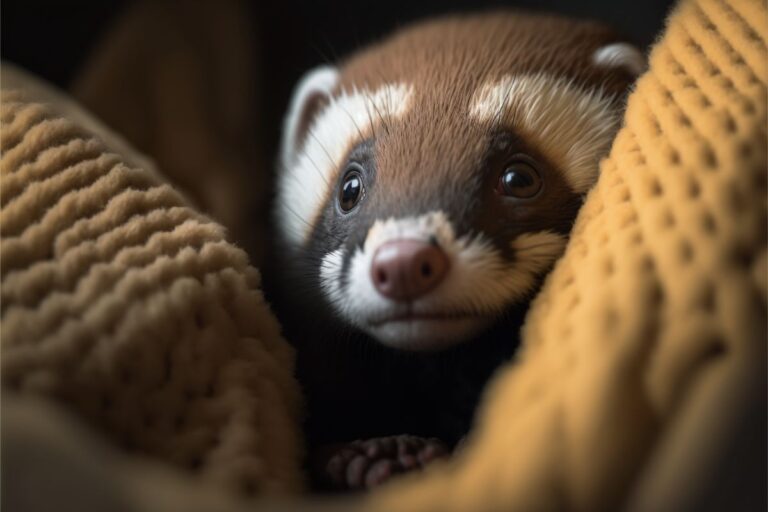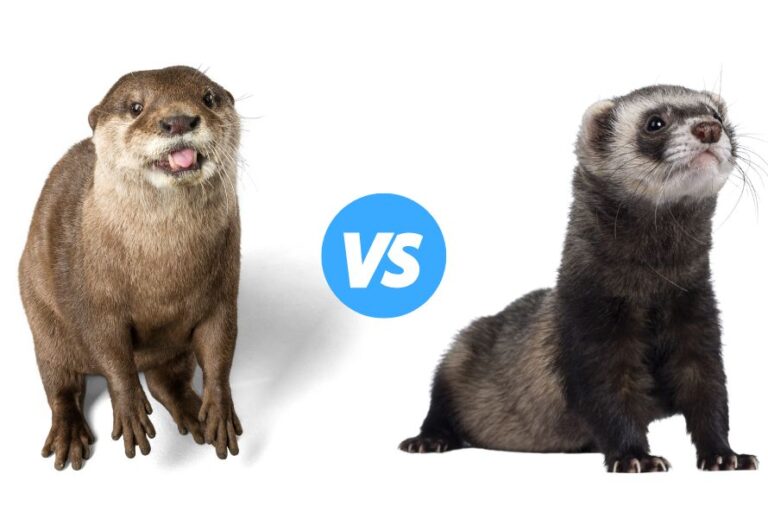Mink vs Ferret: What Are Their Differences?

There are animals across many different species that look remarkably like one another and yet when it comes down to it, they’re nowhere near the same in terms of personality. The ferret and the mink are great examples of this. These two creatures could be quite easily mistaken for one another and yet they couldn’t be any more opposite if they tried.
The most obvious difference between a mink and a ferret is that the ferret has been easily domesticated. On the other hand, the mink is very much a wild animal and it would be unlikely that they would ever be suitable for keeping as pets. What’s more, mink are a species all of their own whereas the ferret is a subspecies.
While these are the key differences, there are plenty of other ways that these animals are different from one another. So, even though you might mistake them at first glance, you’ll soon come to realize that these cousins aren’t as close as they appear.
Meet The Mink
There are two main breeds of mink and these animals are very closely related to the weasel. While there are mink in the wild, they are generally bred in captivity by farmers.
Mink are semi-aquatic animals and have the ability to dive down into the water as deep as 12 feet. Carnivorous animals, mink typically scour the shoreline for mice, frogs, eggs, and small birds. These animals don’t live in groups and the only time that you might see them being sociable is during mating season.
Owing to the fact that mink can be aggressive and require at least a pond, if not a bigger body of water, they aren’t typically kept as pets. They are not as easily domesticated as a ferret but, as we have already mentioned, they are bred on farms. You might also see them in zoos where much more space and a more natural environment can be provided for them.
The first most common breed is the American mink which is typically farmed for its fur. This semi-aquatic animal is usually much bigger than its wild counterparts owing to the improved diet which farmers offer so that they can get bigger furs. The American mink comes in a wide range of colors such as white, blue, sapphire, pearl, and black.
On the other side of the pond, you will find the European mink which in many ways is the same as its American cousin. The size of the two animals is similar and they are both farmed for their fur. However, the key difference with the European mink is that it tends to have a much calmer character and is not as aggressive. You’ll notice also that the coloration is different with the European mink typically being brown and sometimes having white markings.
Meet The Ferret
Ferrets may look similar to mink, but this appearance is quite different when you look more closely, but we will explore this a little later on. For now, let’s get better acquainted with the ferret.
Where mink tend to live near water, ferrets are often found on grassy plains and are not semi-aquatic animals. However, they are similar to mink in that both animals can be found burrowing in dens and tunnels under the ground. That said, they will normally seek out existing tunnels that have been dug by other animals like prairie dogs.
Differences In Appearance
To the untrained eye, a ferret and a mink might look incredibly similar and there is no denying that they do have a few traits that make them look the same. They both have long, slim bodies and pointy teeth with small round ears. This is because they are from the same mammal family. But when you look more closely, you will see that the two creatures are vastly different, if equally as cute.
Ferrets tend to be much larger than mink and some adults can grow to be twice the size. For example, the average adult mink will be anywhere between 12 and 20 inches in length. On the other hand, a fully grown ferret might be anywhere between 18 and 24 inches. That said, they are typically that much heavier than a mink whose thick fur accounts for much of his weight.
As well as looking slightly different and coming in different colors, these two animals have very different life spans. The mink may live almost twice as long as the ferret at the extreme end of the scale. They can live between 9 and 11 years whereas the ferret might last as little as 5 years. That said, there are some healthy ferrets that live as long as 9 years.
Differences In Temperament
One of the key differences between mink and ferrets is that their temperaments are plains apart. This is one of the main reasons that ferrets make good pets and mink do not. Of course, this also relates to being able to provide the animal with a suitable habitat.
Ferrets are incredibly playful animals that are brimming with curiosity. They love to explore and will happily spend hours interacting with other ferrets and their owners. Although, keep in mind that they may not get along with other pet species such as cats and dogs. What’s more, when they are well taken care of and feel safe, they will often form a very strong bond with their owners.
With all of that in mind, if you want to form a good bond with your ferret, you will need to dedicate the time and attention to him from a young age. This will help him get used to being handled and will allow him to trust you more quickly. While most ferrets will thrive in a group or at least a pair, there are some whose temperament might be a little more feisty and they may need to be kept alone. But for the most part, they are very sociable and loving animals.
On the other hand, mink are much more aggressive and don’t typically bond with humans. They might be equally as curious as a ferret but not so much so that they will waste their time frolicking with us mere human beings. The males can be incredibly territorial and so it is not uncommon for fights to break out. This is one of the reasons that they are such loners in the wild.
Caring For Mink vs Ferret
We have made it quite clear that a mink is not a suitable pet but let’s take a closer look at the differences in care for these animals.
In terms of space, a mink would need a much larger area that included some body of water. At the very least, this would need to be a pond. While you might not be able to keep a mink as a pet, if you’re lucky enough to live very close to their natural habitat, you might spot one from time to time and there is no greater pleasure than watching animals in nature.
On the other hand, a ferret can be domesticated and while they do need a decent amount of space, this isn’t as complex as the mink. According to the PDSA, ferrets require at least 10m² for their enclosure. But if you have the space to go bigger, then there is nothing wrong in doing so, in fact, your ferret will likely thank you. In his own way, at least. You will also need to make sure that your ferret has lots to keep him occupied in the way of toys and tunnels.
Keeping a mink in captivity can be difficult when you are attempting to replicate its natural diet. These animals tend to go for larger prey than ferrets which would be tricky to source. As we have already discussed, they may feast on small birds, frogs, and they’ll even go for the occasional salamander!
Ferrets’ diets are much easier to provide as while they are still carnivores, they tend to stick to things like insects but will be equally happy eating kitten food. (don’t give them dog food, as this is not nutritionally beneficial for them.) There is also the option to offer specifically made ferret food which is widely available. Your ferret will even be happy chewing meat off of the bone.
If you are going to keep a ferret as a pet, you will need to make sure that they have plenty of company because these are incredibly sociable animals. There may be some individual ferrets that have the type of personality that means they cannot be kept with others but in the main, they should be kept in small groups. What’s more, you will need to ensure that your ferret spends plenty of time interacting with you and other members of your family. This will allow you to form a solid and stable bond with him.
Keeping a mink in captivity would prove to be much more hassle as they would need to have plenty of tunnels and dens to feel safe. They would also need much more space and could not be kept in groups owing to their territorial nature. However, when they are kept on farms and in zoos, they are given more than enough room that groups can live in the same area without treading on each others’ toes.
Ferrets are prone to several health conditions but these aren’t typically things that are difficult to manage. Dental issues, heart problems, and parasites are among the most common ferret health conditions but a good vet will easily be able to manage these to give the animal the best quality of life.
On the other hand, mink are susceptible to far many more health problems and while the list is extensive, some of the most common include urinary tract infections, influenza, mastitis, bacterial diseases, and pneumonia. If you were to take care of a mink, the vet bills would be extraordinarily high and while these animals would last longer in captivity than the wild, they may suffer in the process.
Conclusion
If you want a pet from the mustelid family (that’s things like weasels, ferrets, and mink) then you would be wise to go for a ferret. You can find these animals for sale in pet stores and from breeders across the United States but mink are only kept in captivity for farming their fur. As pets, they are far from suitable.
While mink and ferrets do have a lot of appearance traits in common, they also have many differences both in terms of looks and personality. What’s more, their care needs are remarkably different and most domestic owners would not be able to provide everything the mink needs to thrive.






